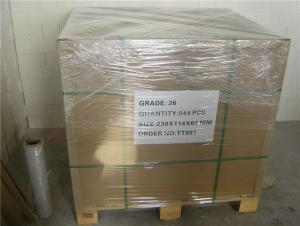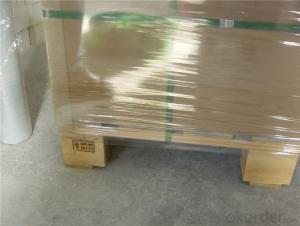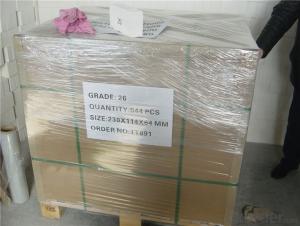Refractory Light Weight Insulation Fire Clay Brick for Heating Furnace
- Loading Port:
- Shanghai
- Payment Terms:
- TT OR LC
- Min Order Qty:
- 1 m.t.
- Supply Capability:
- 1000 m.t./month
OKorder Service Pledge
OKorder Financial Service
You Might Also Like
Thermal Insulation Fire Clay Brick
Refractory brick is a block of refractory ceramic material used in lining furnaces, kilns, fireboxes, and fireplaces.
We provide high quality Refractory Fire Bricks that are used on wide range in the various industries like Cement, Glass and Steel. Refractory Fire Bricks are provided as per the quantity and specifications required by the customers. We provide an extensive range of Refractory Fire Bricks at reasonable prices that depend upon the quantity ordered.
Application
Insulating Fire Brick are used for the lining of converter, alternating current arc furnace, direct Current arc furnace and the ladle slag line, etc.
Company Advantage
(1)Long Insulating Fire Brick manufacture history: 25 years manufacturer
(2)Advanced equipment
(3)Diversification of production standards: ISO ANSI FEPA JIS ASTM
(4)Flexible payment: T/T L/C D/P D/A
(5)Professional marketing team and after-sale service
Insulating Fire Brick main feature:
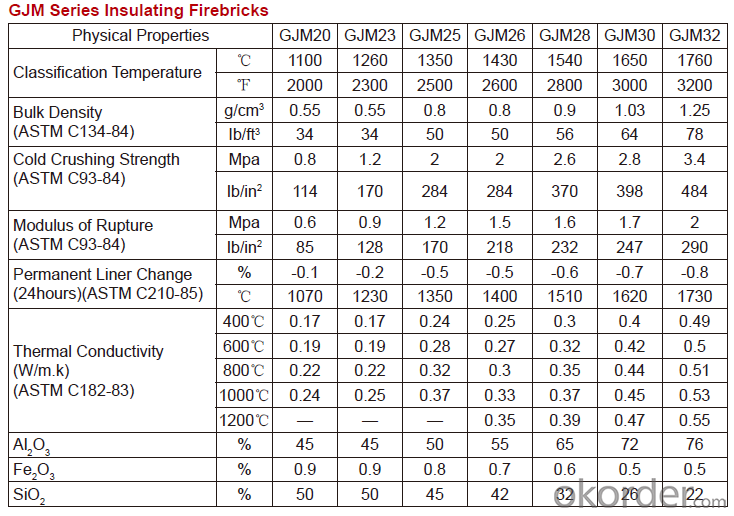
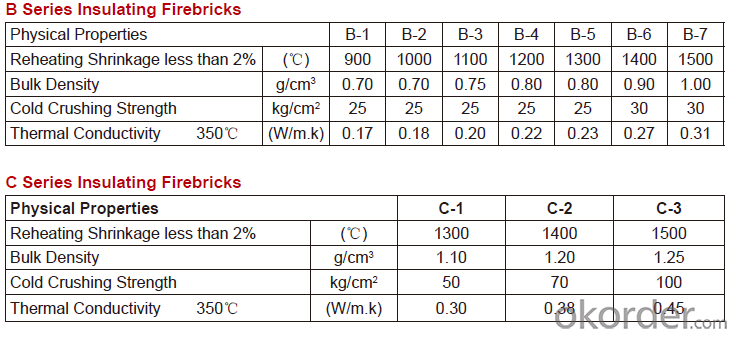
Equipment
1 unit of Ceramic Abrasive (SG Abrasive) pilot production line
2 units of Compact grain Abrasive pilot production lines
1 unit of high-end coated abrasives (abrasive cloth) production line
2 units of Boron Carbide production lines
3 large flexible crushing and sieving lines for grit production lines
6 units of 5000KVA-10000KVA dumping type electric arc furnaces for Brown Fused Alumina fusion
Q1 What’s the transport method?
A1 FCL delivery goods with wooden pallet or wooden case by sea; If LCL delivery, must with wooden case; Sometimes need open top, flat rack or bulk cargo.
Q2 What’s the required payment term?
A2 Generally 30% TT as the prepayment, 70% TT before delivery. If need, 100% Irrevocable Letter of Credit or negotiation.
Q3 Which country are our products exported to?
A3 Apart from entire Chinese market, the US, Russia, Japan, Korea, Australia and some Southeast Asian Nations.
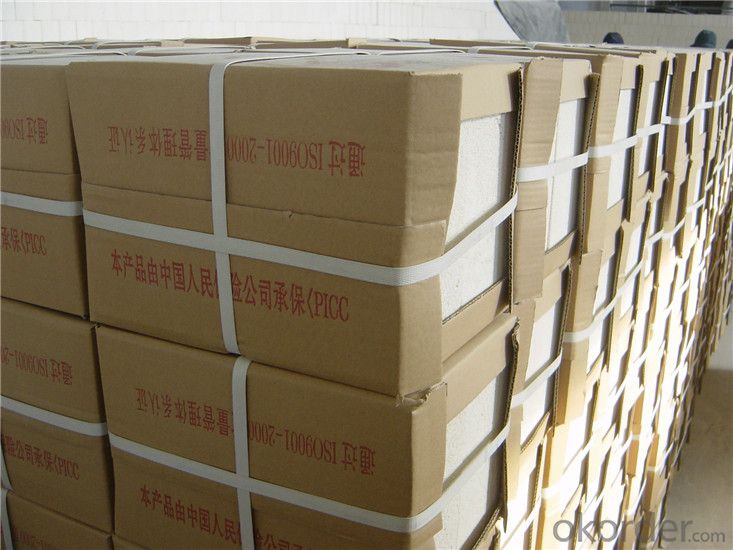

- Q:Can insulating fire bricks be used in heat exchangers?
- Yes, insulating fire bricks can be used in heat exchangers. These bricks are designed to have excellent thermal insulation properties, making them suitable for applications where heat needs to be contained or transferred efficiently. Heat exchangers rely on the efficient transfer of thermal energy, and insulating fire bricks can help in reducing heat loss or gain in these systems, improving their overall efficiency.
- Q:Are insulating fire bricks resistant to slag attack?
- Yes, insulating fire bricks are generally resistant to slag attack. Insulating fire bricks are made from lightweight and porous materials, such as alumina, silica, and other refractory materials. These bricks are designed to provide excellent insulation and high-temperature resistance in various industrial applications, including furnaces, kilns, and incinerators. Slag attack refers to the corrosion or erosion caused by molten slag, which is a byproduct of certain industrial processes like metal smelting or coal combustion. Slag can be highly corrosive and can cause damage to refractory materials, including fire bricks. However, insulating fire bricks are specifically formulated to have a high resistance to slag attack. Their composition and structure allow them to withstand the corrosive nature of molten slag, preventing erosion and maintaining their insulating properties over time. Moreover, insulating fire bricks can also have different levels of slag resistance, depending on their specific composition and manufacturing process. Some fire bricks may have additional additives or coatings to enhance their resistance to slag attack. It is important to note that while insulating fire bricks offer good resistance to slag attack, the severity and duration of exposure to slag can also impact their performance. In highly corrosive environments or prolonged exposure to molten slag, even the most resistant fire bricks may eventually experience some level of degradation. Overall, insulating fire bricks are a reliable choice for applications where resistance to slag attack is required. However, it is always recommended to consult with a refractory engineer or supplier to ensure the appropriate selection of fire bricks based on the specific conditions and requirements of the industrial process.
- Q:Can insulating fire bricks be used in high-temperature insulation boards?
- Yes, insulating fire bricks can be used in high-temperature insulation boards. Insulating fire bricks are designed to withstand high temperatures and provide excellent thermal insulation. They can be easily incorporated into insulation boards to enhance their insulating properties and increase their resistance to heat.
- Q:Can insulating fire bricks be used for insulation in refractory lining repair?
- Yes, insulating fire bricks can be used for insulation in refractory lining repair. Insulating fire bricks are made from lightweight materials that have excellent thermal insulation properties, making them ideal for use in high-temperature applications such as furnaces, kilns, and other refractory lining structures. These bricks have low thermal conductivity and high resistance to thermal shock, allowing them to effectively insulate and protect the refractory lining from heat, preventing heat loss and reducing energy consumption. Moreover, insulating fire bricks are easy to install and replace, making them a cost-effective choice for refractory lining repair.
- Q:Can insulating fire bricks be used in fertilizer plants?
- Yes, insulating fire bricks can be used in fertilizer plants. They are commonly used in high-temperature applications, such as kilns and furnaces, to provide thermal insulation and protect against heat loss. In fertilizer plants, where various processes involve high temperatures, insulating fire bricks can be utilized to enhance energy efficiency and maintain optimal temperature conditions.
- Q:Can insulating fire bricks be used as a lining for chimneys?
- Yes, insulating fire bricks can be used as a lining for chimneys. These bricks are designed to withstand high temperatures and provide insulation, making them suitable for lining chimneys and protecting them from heat damage.
- Q:Are insulating fire bricks resistant to warping?
- Yes, insulating fire bricks are generally resistant to warping. Insulating fire bricks are designed to withstand high temperatures and thermal shocks, which helps prevent warping. These bricks are made from lightweight materials such as clay, silica, and alumina, combined with additives to enhance their insulating properties. These additives also contribute to the brick's ability to resist warping. Additionally, insulating fire bricks undergo a specific manufacturing process that helps ensure dimensional stability and minimize the risk of warping. However, it's important to note that extreme and prolonged exposure to high temperatures can still cause some degree of warping, but compared to other types of bricks, insulating fire bricks offer a higher level of resistance.
- Q:Can insulating fire bricks be used in refractory fibers?
- Insulating fire bricks are not suitable for use in refractory fibers. These bricks are solid and made from refractory materials, serving to insulate and retain heat in high-temperature scenarios. Conversely, refractory fibers are lightweight and flexible materials composed of ceramic or mineral fibers. They are employed for insulation and lining in a range of industrial applications, such as furnaces, kilns, and boilers. Due to their distinct properties and structures, these two materials are incompatible. Consequently, it is advisable to refrain from using insulating fire bricks in conjunction with refractory fibers.
- Q:Can insulating fire bricks be used in DIY projects?
- Yes, insulating fire bricks can be used in DIY projects. They are commonly used in various DIY applications such as constructing fire pits, ovens, kilns, and for lining chimneys. These bricks have excellent insulation properties, can withstand high temperatures, and are easy to work with, making them ideal for DIY projects requiring heat resistance.
- Q:Are insulating fire bricks suitable for use in carbon black furnaces?
- Yes, insulating fire bricks are suitable for use in carbon black furnaces. Insulating fire bricks are made from refractory materials that have excellent insulation properties, which makes them ideal for high-temperature applications such as carbon black furnaces. Carbon black furnaces operate at extremely high temperatures, typically above 1,000 degrees Celsius, and the use of insulating fire bricks helps to reduce heat loss and improve energy efficiency. These bricks also have good thermal shock resistance, which is crucial for the cyclic heating and cooling that occurs in the furnace. Additionally, insulating fire bricks have low thermal conductivity, which helps to maintain a stable temperature inside the furnace and prevent excessive heat loss. Overall, insulating fire bricks are a reliable and effective choice for lining carbon black furnaces.
1. Manufacturer Overview |
|
|---|---|
| Location | |
| Year Established | |
| Annual Output Value | |
| Main Markets | |
| Company Certifications | |
2. Manufacturer Certificates |
|
|---|---|
| a) Certification Name | |
| Range | |
| Reference | |
| Validity Period | |
3. Manufacturer Capability |
|
|---|---|
| a)Trade Capacity | |
| Nearest Port | |
| Export Percentage | |
| No.of Employees in Trade Department | |
| Language Spoken: | |
| b)Factory Information | |
| Factory Size: | |
| No. of Production Lines | |
| Contract Manufacturing | |
| Product Price Range | |
Send your message to us
Refractory Light Weight Insulation Fire Clay Brick for Heating Furnace
- Loading Port:
- Shanghai
- Payment Terms:
- TT OR LC
- Min Order Qty:
- 1 m.t.
- Supply Capability:
- 1000 m.t./month
OKorder Service Pledge
OKorder Financial Service
Similar products
New products
Hot products
Related keywords

